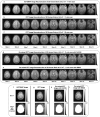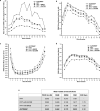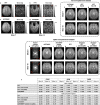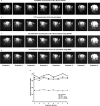Boosting the signal-to-noise of low-field MRI with deep learning image reconstruction
- PMID: 33859218
- PMCID: PMC8050246
- DOI: 10.1038/s41598-021-87482-7
Boosting the signal-to-noise of low-field MRI with deep learning image reconstruction
Abstract
Recent years have seen a resurgence of interest in inexpensive low magnetic field (< 0.3 T) MRI systems mainly due to advances in magnet, coil and gradient set designs. Most of these advances have focused on improving hardware and signal acquisition strategies, and far less on the use of advanced image reconstruction methods to improve attainable image quality at low field. We describe here the use of our end-to-end deep neural network approach (AUTOMAP) to improve the image quality of highly noise-corrupted low-field MRI data. We compare the performance of this approach to two additional state-of-the-art denoising pipelines. We find that AUTOMAP improves image reconstruction of data acquired on two very different low-field MRI systems: human brain data acquired at 6.5 mT, and plant root data acquired at 47 mT, demonstrating SNR gains above Fourier reconstruction by factors of 1.5- to 4.5-fold, and 3-fold, respectively. In these applications, AUTOMAP outperformed two different contemporary image-based denoising algorithms, and suppressed noise-like spike artifacts in the reconstructed images. The impact of domain-specific training corpora on the reconstruction performance is discussed. The AUTOMAP approach to image reconstruction will enable significant image quality improvements at low-field, especially in highly noise-corrupted environments.
Conflict of interest statement
The authors declare no competing interests.
Figures








Similar articles
-
Performance of a deep learning-based CT image denoising method: Generalizability over dose, reconstruction kernel, and slice thickness.Med Phys. 2022 Feb;49(2):836-853. doi: 10.1002/mp.15430. Epub 2022 Jan 19. Med Phys. 2022. PMID: 34954845
-
Image reconstruction by domain-transform manifold learning.Nature. 2018 Mar 21;555(7697):487-492. doi: 10.1038/nature25988. Nature. 2018. PMID: 29565357
-
SDnDTI: Self-supervised deep learning-based denoising for diffusion tensor MRI.Neuroimage. 2022 Jun;253:119033. doi: 10.1016/j.neuroimage.2022.119033. Epub 2022 Mar 1. Neuroimage. 2022. PMID: 35240299 Free PMC article.
-
Artificial Intelligence-Driven Ultra-Fast Superresolution MRI: 10-Fold Accelerated Musculoskeletal Turbo Spin Echo MRI Within Reach.Invest Radiol. 2023 Jan 1;58(1):28-42. doi: 10.1097/RLI.0000000000000928. Epub 2022 Nov 2. Invest Radiol. 2023. PMID: 36355637 Review.
-
MRI at low field: A review of software solutions for improving SNR.NMR Biomed. 2025 Jan;38(1):e5268. doi: 10.1002/nbm.5268. Epub 2024 Oct 7. NMR Biomed. 2025. PMID: 39375036 Free PMC article. Review.
Cited by
-
Highly accelerated 3D MPRAGE using deep neural network-based reconstruction for brain imaging in children and young adults.Eur Radiol. 2022 Aug;32(8):5468-5479. doi: 10.1007/s00330-022-08687-6. Epub 2022 Mar 22. Eur Radiol. 2022. PMID: 35319078
-
Detection of Intracerebral Hemorrhage Using Low-Field, Portable Magnetic Resonance Imaging in Patients With Stroke.Stroke. 2023 Nov;54(11):2832-2841. doi: 10.1161/STROKEAHA.123.043146. Epub 2023 Oct 5. Stroke. 2023. PMID: 37795593 Free PMC article.
-
A foundation model for generalized brain MRI analysis.medRxiv [Preprint]. 2024 Dec 3:2024.12.02.24317992. doi: 10.1101/2024.12.02.24317992. medRxiv. 2024. PMID: 39677480 Free PMC article. Preprint.
-
GLAPAL-H: Global, Local, And Parts Aware Learner for Hydrocephalus Infection Diagnosis in Low-Field MRI.medRxiv [Preprint]. 2025 Jun 6:2025.05.14.25327461. doi: 10.1101/2025.05.14.25327461. medRxiv. 2025. Update in: IEEE Trans Biomed Eng. 2025 Jun 09;PP. doi: 10.1109/TBME.2025.3578541. PMID: 40463531 Free PMC article. Updated. Preprint.
-
Deep learning denoising reconstruction for improved image quality in fetal cardiac cine MRI.Front Cardiovasc Med. 2024 Feb 12;11:1323443. doi: 10.3389/fcvm.2024.1323443. eCollection 2024. Front Cardiovasc Med. 2024. PMID: 38410246 Free PMC article.
References
Publication types
LinkOut - more resources
Full Text Sources
Other Literature Sources

